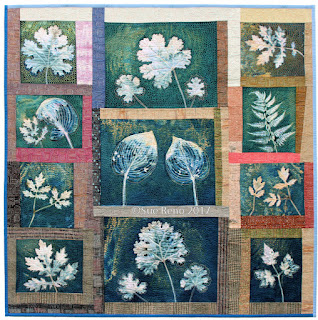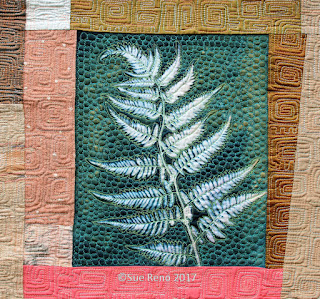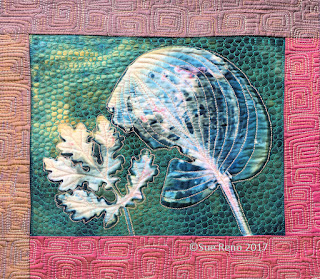Welcome to part 27 of my experiments in wet cyanotype. This time I was once again all about the heat and humidity, as we had plenty of both. Temperatures in the high 90s F are not ideal, but I had the time and wanted to try. I went with a stargazer lily again, as they are plentiful in bloom this year, and their moment is fleeting. They are a substantial, thick petaled flower which helps. I also picked some Shasta daisies; they had been suffering in the drought and were on the small side.
For the rest I went with my old reliables, Japanese anemone leaves, along with a hosta and a wood poppy leaf.
As expected, conditions in the blazing sun made the the cyanotype chemicals, and the moisture from the plants, move around rapidly and chaotically. I left them out for about 5 hours in the mid day sun, at which point there were obviously cooked enough. Here are the finished, un-rinsed prints. The images are a bit foggy from condensation on my lens--it was extremely humid!
The stargazer held up well. The shastas are looking a bit blobby.
I spritzed a bit of heavily diluted red textile paint on a few of these, and it wicked around in hard lines this time.
The hot sun cooked some of the sap from the wood poppy leaves into a partial eco-print.
Here are the finished prints. There's some wonderful photographic detail on the stargazer.
The shasta daisies turned out better than expected. I can easily detail the petals later.
The stem of the right anemone leaf bled out in a cool pattern, and I like what's going on the top of this one.
I've never had this hard edged paint line happen before, so I'm pleased with this one!
Hosta leaves are always such great subjects for this method.
And the wood poppy print has a lot going on as well. All in all, a good batch! These were done in a dry spell, in advance of the current rain deluge, so conditions will have changed dramatically when I am ready to print again. I really like the way these prints have an immediacy about them, a moment in time and space captured in the garden that endures.
As always, thanks for reading and commenting!
And a reminder that I also post on social media:
Facebook page:http://www.facebook.com/suerenostudio
Twitter feed: http://twitter.com/suereno
Tumblr: http://suerenostudio.tumblr.com
Instagram: https://www.instagram.com/sue_reno_studio/
July 2022 Update: This post has been doing some numbers, so I wanted to say hello, and thank you, to everyone stopping by. I also wanted to let you know that this exploration turned into a series of 78 posts, and counting! You can easily access them, in reverse chronological order, by clicking on the Wet Cyanotype tab in the top header. I share a lot of details about what I've tried, and am always honest about the results in each post. Mixed in is the occasional post showing artquits I've made with my prints. I hope you enjoy reading my blog, learn a thing or two, and try your own hand at this very enjoyable process.
August 2023 Update: Still doing some numbers, still doing new experiments! I'm up to Experiments in wet cyanotype - part 83 and I continue to be grateful for all the interest and support. Here's the updated list of my socials, I'd love to have you follow along on the platform of your choice:









